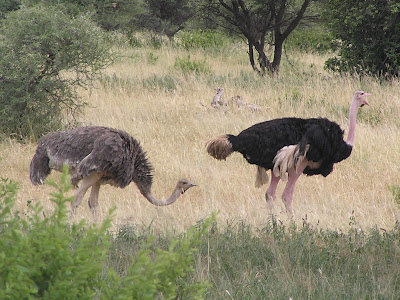 |
| Ostriches (Struthio camelus) are sexually dimorphic. The male (right) has a pinkish neck and legs, and black and white feathers. The female (left) is mostly brown. |
When males and females of the same species have different physical forms, it is called sexual dimorphism. These differences can be in body parts, color patterns, and size. If you are trying to identify a species, recognition that the sexes may appear different is key. I once met a woman who swore she had two species of cardinals in her yard, but after a bird walk she discovered the Northern Cardinal males are bright red whereas the females are greyish red. Same species, but different looking.
Why?
 |
| Black-and-white casqued hornbills (Bycanistes subcylindricus). The male on the left has a much larger casque on his bill and less red bare skin around his eye than the female on the right. |
On the surface, it would appear that the bright colors, long tail feathers, different size, etc. are ways of attracting mates. But birds do not choose to look the way they do. These differences are produced by their genes. So why do the males and females of the same species look different?
 |
| I re-post this photo of southern red bishops (Euplectes orix) because it shows the strong difference between the male (left) and the female (right). |
It would be easy to explain if females picked males with the sharpest claws, strongest wings, or some other characteristic that increased his chance of survival. This does happen in that only the individuals who can survive long enough to breed actually get to pass on their genes (natural selection). But color, tail length, and other “ornamentation” differences in birds are not so obvious. They have no apparent function other than attracting a mate.
 |
| A male pin-tailed whydah (Vidua macroura). |
Males (and in a much smaller number of species, females) are driven to differences by the opposite sex that select them to breed with; then the genes of the male are passed on (sexual selection). So for example, if a male bird with a brighter red color than other males of its species, is chosen to breed by more females, then more of his genes are passed on to his offspring (assuming the brighter red color is a genetic). With more genes for the brighter red color in the population, if females continue to select the brighter red males, then males continue to be the brighter red color. This is straightforward biology, but it still doesn’t answer the question of why the birds select differences in the first place.
 |
| Female pin-tailed whydahs (Vidua macroura). |
We really do not know much about why birds select their mates when it comes to ornamentation. The fantastic details may help females distinguish their species from another similar one. The showy details may announce an individual’s presence so loudly that to defy getting eaten by a predator is to imply genetic superiority. It is possible that what we see as fantastic details are byproducts of some unforeseen trait; for a hypothetical example, it may be that the gene for long tails is just passed on because the birds who had them happened to have better territories or have stronger bones (but through no connection to the longer tail itself).
 |
| A male black cuckoo-shrike (Campephaga flava) is dark and glossy with just a small yellow gape behind the bill. |
Whatever the reasons may be, sexual dimorphism is a defining aspect in the appearance of many bird species. People sometimes ask me why the males are more beautiful, but I remind them that beauty is in the eye of the beholder. It is the female birds that do the choosing, so they have the power in the relationship (not to anthropomorphize). Inspired by slogans from the early 20th century women’s rights movements (like “equal pay for equal work”), Michele and I joke about creating a feminist-birding blog dedicated to females birds called “Equal viewing for equal birds!” Although not as showy, female birds (and non-breeding plumage males and juvenile birds) have a subtle beauty that is worth seeing too.
 |
| A female black cuckoo-shrike (Campephaga flava) is beautiful on her own. |
Works Consulted
- Dawkins, R. The Greatest Show on Earth. London: Random House Group, 2009.
- Ehrlich, P, et al. "Sexual Selection." Birds of Stanford. Accessed: October 17, 2011. http://www.stanford.edu/group/stanfordbirds/text/essays/Sexual_Selection.html
- Fanshawe, J. and Stevenson, T. Birds of East Africa. Princeton and Oxford: Princeton University Press, 2002.
- Owens, I. and Hartley, I. 1998. "Sexual dimorphism in birds: why are there so many different forms of dimorphism?" National Center for Biotechnology Information. Accessed October 16 2011 at: http://www.ncbi.nlm.nih.gov/pmc/articles/PMC1688905/pdf/RQQD3PMMWYMYQD4H_265_397.pdf
No comments:
Post a Comment